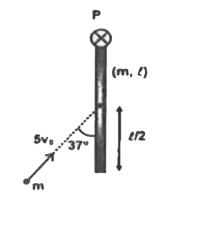The adjacent figure shows an infinite frame of two sides in a gravity - free space. What is the final constant kinetic energy expected of the ball of mass m projected as shown with an initial velocity v0? The coefficient of restitution for the collision between the ball and the frame is e=0.5.

0.5mv20
0.25mv20
0.125mv20
0.325mv20
The correct Answer is:B
Step by step video & image solution for The adjacent figure shows an infinite frame of two sides in a gravity - free space. What is the final constant kinetic energy expected of the ball of mass m projected as shown with an initial velocity v_0? The coefficient of restitution for the collision between the ball and the frame is e = 0.5. by Physics experts to help you in doubts & scoring excellent marks in Class 12 exams.
Updated on:21/07/2023Topper's Solved these Questions
Similar Questions
Two identical balls A and B are moving as shown in the fig. Ball A hits a smooth floor head on with a velocity u and at the same instant ball B strikes A head on with a horizontal velocity u. The collision between A and B is perfectly inelastic whereas the coefficient of restitution for collision between A and the floor is e=0.5. At what time the two balls will collide again? Assume friction to be absent everywhere.

View SolutionA ball of mass m moving at speed v makes a head on collision with an identical ball at rest. The kinetic energy of the balls after the collision is 3/4th of the original. Find the coefficient of restitution.
View Solution
Knowledge Check
A ball of mass m moving with a speed v makes a head on collision with an identical ball at rest. The kinetic energy after collision of the balls is three fourth of the original kinetic energy. The coefficient of restitution is
A12B13C1√2D1√3Ball 1 collides with an another identical ball 2 at rest as shown in figure. For what value of coefficient of restitution e, the velocity of ball 2 becomes two times that of ball I after collision?
 A13B12C14D16
A13B12C14D16Rod can rotate about hinge point 'P'. A ball of mass 'm' is projected with a velocity 5v0 in a gravity free space as shown in figure. Collision between the rod and the ball is perfectly elastic. Then find the magnitude of velocity of ball after the collision ( neglect the friction between the ball and the rod during the collision ).
 A√64949v0B√86549v0C√56349v0D√77249v0
A√64949v0B√86549v0C√56349v0D√77249v0
On a frictionless surface, a ball of mass m moving at a speed v makes a head on collision with an identical ball at rest. The kinetic energy of the balls after the collision is 3/4th of the original. Find the coefficient of restitution.
View SolutionBall A is about to hit a wall at an angle of incidence of θ=30∘. But before hitting the wall it made a head on collision with another identical ball B. The ball B then collides with the wall. The coefficient of restitution for collision between two balls is e1=0.8 and that between a ball and the wall is e1=0.6. Find the final velocity of ball B. Initial velocity of A was u=5ms−1. Neglect friction.
[tan−1(2.252.34)=44∘]

View SolutionA ball of mass m moving at a speed v makes a head on inelastic collision with an identical ball at rest. The kinetic energy of the balls after the collision is 34th of the original. Find the coefficient of restitution.


View SolutionIn the arrangement shown in Fig. the ball and the block have the same mass m=1kg each, θ=60∘ and length l=2.50m. Coefficient of friction between the block and the floor is 0.5. When the ball is released from the position shown in Fig. it collides with the block and the block stops after moving a distance 2.50m.

The coefficient of restitution for collision between the ball and the block is
View SolutionA ball of mass m moving with a speed 2v0 collides head-on with an identical ball at rest. If e is the coefficient of restitution, then what will be the ratio of velocity of two balls after collision?
View Solution
